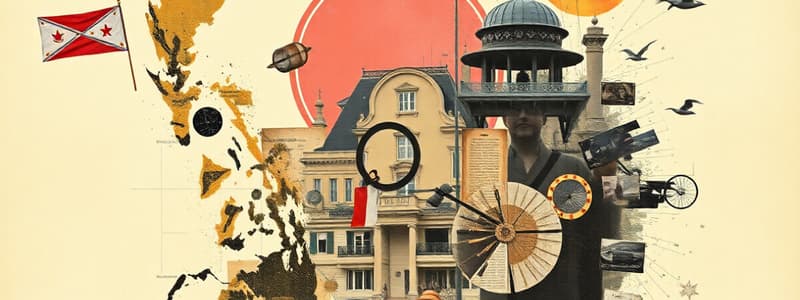Podcast
Questions and Answers
What is the total number of islands that make up the country in Southeast Asia?
What is the total number of islands that make up the country in Southeast Asia?
- Over 5,000 islands
- Over 7,600 islands (correct)
- Less than 7,000 islands
- Between 8,000 and 10,000 islands
Which major island is NOT one of the main islands identified?
Which major island is NOT one of the main islands identified?
- Mindanao
- Java (correct)
- Visayas
- Luzon
During which period did the Spanish colonization occur?
During which period did the Spanish colonization occur?
- 1565-1898 (correct)
- 1492-1565
- 1946-present
- 1898-1946
What is the role of the president in the government?
What is the role of the president in the government?
Which of the following is NOT a major export of the country?
Which of the following is NOT a major export of the country?
Which UNESCO World Heritage site is known for its rice terraces?
Which UNESCO World Heritage site is known for its rice terraces?
Which festival is recognized for showcasing vibrant local traditions?
Which festival is recognized for showcasing vibrant local traditions?
What are the two national languages of the country?
What are the two national languages of the country?
Flashcards are hidden until you start studying
Study Notes
Geography
- Located in Southeast Asia, consisting of over 7,600 islands.
- Major islands include Luzon, Visayas, and Mindanao.
- The country is divided into 17 regions and is surrounded by the Pacific Ocean.
Culture
- Diverse cultural heritage influenced by Malay, Spanish, American, and Chinese traditions.
- National languages: Filipino and English; over 170 languages/dialects are spoken.
- Known for folk dances (Tinikling, Pandanggo sa Ilaw) and diverse music genres.
History
- Pre-colonial period marked by various tribes and chiefdoms.
- Spanish colonization (1565-1898) introduced Christianity and socio-political structures.
- American occupation (1898-1946) led to English education and political changes.
- Gained independence on July 4, 1946.
Government
- Democratic republic with a president as both head of state and government.
- Bicameral legislature: Senate and House of Representatives.
- Local government units: provinces, cities, municipalities, and barangays.
Economy
- Emerging economy; major sectors include agriculture, manufacturing, mining, and services.
- Major exports: electronics, garments, coconut oil, and fruits.
- Tourism is a key industry, known for natural beauty (beaches, volcanoes, and heritage sites).
Biodiversity
- Known for rich biodiversity; home to numerous endemic species.
- Important ecological regions: Coral Triangle and rainforest ecosystems.
- Conservation efforts are critical due to threats from habitat loss and climate change.
Issues and Challenges
- Poverty and inequality remain significant concerns.
- Political issues include corruption, governance challenges, and human rights.
- Natural disasters (typhoons, earthquakes) frequently impact communities.
Notable Landmarks
- Rizal Park in Manila, a site honoring national hero Jose Rizal.
- Banaue Rice Terraces, a UNESCO World Heritage site.
- Puerto Princesa Subterranean River, a natural wonder and UNESCO site.
Festivals
- Sinulog, Ati-Atihan, and Pahiyas showcase vibrant local traditions and garner tourism.
- Christmas celebrations are among the longest in the world, marked by unique customs.
Geography
- Consists of over 7,600 islands located in Southeast Asia.
- Major islands include Luzon, Visayas, and Mindanao.
- Surrounded by the Pacific Ocean and divided into 17 regions.
Culture
- A blend of Malay, Spanish, American, and Chinese traditions.
- Filipino and English are the national languages.
- Over 170 languages/dialects are spoken.
- Known for folk dances like Tinikling and Pandanggo sa Ilaw, and diverse music genres.
History
- Pre-colonial period featured various tribes and chiefdoms.
- Spanish colonization (1565-1898) introduced Christianity and socio-political structures.
- American occupation (1898-1946) brought English education and political changes.
- Gained independence on July 4, 1946.
Government
- Democratic republic with a president as head of state and government.
- Bicameral legislature: Senate and House of Representatives.
- Local government units include provinces, cities, municipalities, and barangays.
Economy
- Emerging economy with major sectors including agriculture, manufacturing, mining, and services.
- Key exports include electronics, garments, coconut oil, and fruits.
- Tourism is a significant industry, known for natural beauty like beaches, volcanoes, and heritage sites.
Biodiversity
- Rich biodiversity, home to numerous endemic species.
- Important ecological regions include the Coral Triangle and rainforest ecosystems.
- Conservation efforts are critical due to threats from habitat loss and climate change.
Issues and Challenges
- Poverty and inequality remain significant concerns.
- Political issues include corruption, governance challenges, and human rights.
- Natural disasters like typhoons and earthquakes frequently impact communities.
Notable Landmarks
- Rizal Park in Manila, a site honoring national hero Jose Rizal.
- Banaue Rice Terraces, a UNESCO World Heritage site.
- Puerto Princesa Subterranean River, a natural wonder and UNESCO site.
Festivals
- Sinulog, Ati-Atihan, and Pahiyas showcase vibrant local traditions and attract tourism.
- Christmas celebrations are among the longest in the world, marked by unique customs.
Studying That Suits You
Use AI to generate personalized quizzes and flashcards to suit your learning preferences.



